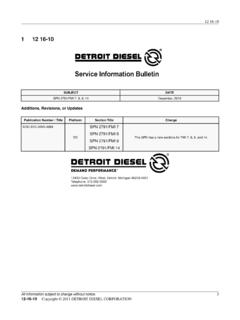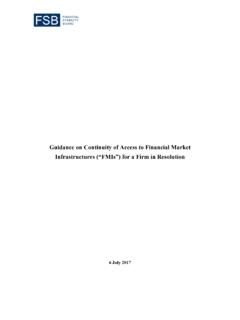Transcription of Chemical, Biological, Radiological, Nuclear and High Yield ...
1 FMI January 2008 chemical , biological , radiological , Nuclear , and high Yield explosives operational headquarters DISTRIBUTION RESTRICTION: Approved for public release; distribution is unlimited. headquarters , DEPARTMENT OF THE ARMY This publication is available at Army Knowledge Online < > and the General Dennis J. Reimer Training and Doctrine Digital Library at < >. FMI DISTRIBUTION RESTRICTION: Approved for public release; distribution is unlimited. i Field Manual Interim No. headquarters DEPARTMENT OF THE ARMY Washington, DC, 24 January 2008 chemical , biological , radiological , Nuclear , and high Yield explosives operational headquarters Contents Page PREFACE ..v INTRODUCTION ..vii Chapter 1 operational 1-1 Understanding the operational Environment ..1-1 operational 1-4 The Nature of chemical , biological , radiological , Nuclear , and high Yield explosives 1-8 Unified Action.
2 1-10 Soldier and Civilian 1-12 Chapter 2 UNIT STRUCTURE, CAPABILITIES, AND AUGMENTATION .. 2-1 Mission and Mission Sets .. 2-1 The headquarters 2-3 Command Group .. 2-3 operational Command 2-4 Main Command Post .. 2-7 Specialized Organic Response Assets .. 2-9 Augmentation .. 2-12 Chapter 3 FULL SPECTRUM OPERATIONS .. 3-1 The Spectrum of Conflict .. 3-1 The operational 3-2 The Elements of Full Spectrum Operations .. 3-7 Chapter 4 WEAPONS OF MASS DESTRUCTION ELIMINATION 4-1 The Elimination 4-1 Encountering Weapons of Mass Destruction Elimination Sites .. 4-8 Chapter 5 COMMAND AND 5-1 5-1 Contents The Role of the 5-2 Enabling Information 5-3 The Operations 5-5 Chapter 6 SUSTAINMENT .. 6-1 Sustainment 6-1 Sustainment 6-1 Nonstandard 6-2 Appendix A FUNDAMENTALS OF COMBATING WEAPONS OF MASS DESTRUCTION A-1 Appendix B STAFF ROLES AND B-1 Appendix C WEAPONS OF MASS DESTRUCTION COORDINATION C-1 Appendix D Nuclear DISABLEMENT D-1 Appendix E chemical , biological , radiological , Nuclear , AND high Yield explosives ANALYTICAL AND REMEDIATION ACTIVITY.
3 E-1 Appendix F JOINT ELIMINATION COORDINATION ELEMENTS ..F-1 Appendix G TRAINING FOR FULL SPECTRUM G-1 Appendix H MEDICAL LABORATORY H-1 SOURCE NOTES .. Source Notes-1 GLOSSARY ..Glossary-1 References-1 INDEX ..Index-1 Figures Figure 1-1. ASCOPE construct with examples .. 1-8 Figure 1-2. The joint spectrum of 1-11 Figure 2-1. Example of a CBRNE operational 2-3 Figure 2-2. Example of a JOC for a JTF-E 2-5 Figure 2-3. Example of a MCP of the CBRNE operational headquarters .. 2-8 Figure 2-4. Example of WCEs within the CBRNE operational headquarters .. 2-10 Figure 2-5. Example of NDTs within the CBRNE operational headquarters .. 2-11 Figure 2-6. Example of a CARA within the CBRNE operational headquarters .. 2-12 Figure 2-7. Example of a JECE and other augmentation in support of a JTF-E.
4 2-13 Figure 3-1. The spectrum of conflict .. 3-1 Figure 3-2. Full spectrum operations the Army s operational concept .. 3-2 Figure 3-3. WMD mission areas within the spectrum of 3-3 Figure 3-4. Example of employments CBRNE operational headquarters .. 3-5 Figure 3-5. Example of WCE support to an Army or joint 3-6 Figure 3-6. Example of OCP support to a joint 3-6 Figure 3-7. Example of JTF-E support to a joint 3-7 Figure 4-1. operational and tactical tasks in the WMD-E mission area .. 4-2 ii FM 24 January 2008 Contents Figure 4-2. operational task isolation .. 4-3 Figure 4-3. operational task exploitation .. 4-5 Figure 4-4. operational task destruction .. 4-7 Figure 4-5. WMD-E operational tasks 4-11 Figure 4-6. Example of maneuver forces locating WMD-E 4-12 Figure 4-7. Example of CBRN brigade exploitation force maneuvering to WMD-E 4-13 Figure 4-8. Example of consolidation to support monitoring and redirection missions.
5 4-14 Figure 5-1. C2 for CBRNE 5-2 Figure 5-2. CCIR .. 5-4 Figure 5-3. Developing 5-5 Figure 5-4. Operations 5-6 Figure 5-5. The MDMP .. 5-7 Figure 5-6. TECHINT collection and 5-9 Figure 5-7. CCIR development and review 5-11 Figure 5-8. Tasking development example ..5-16 Figure 6-1. Example of logistics support for WMD-E 6-2 Figure A-1. NMS-CWMD .. A-1 Figure A-2. Response to proliferation A-4 Figure A-3. Strategic military framework to combat WMD .. A-6 Figure A-4. CBRNE operational headquarters role in combating WMD .. A-8 Figure B-1. Staff elements of the B-2 Figure B-2. Staff elements of the B-7 Figure C-1. Example of a WCE ..C-3 Figure E-1. CARA E-2 Figure E-2. Concept of an RRT and MMAS performing continuous operations .. E-4 Figure H-1. Levels of identification Figure H-2. The new LRN designation ..H-12 24 January 2008 FM iii Contents Tables Table 3-1. Elements of full spectrum operations.
6 3-7 Table G-1. Collective task training ..G-4 iv FM 24 January 2008 Preface Doctrine provides a military organization with unity of effort and a common philosophy, language, and purpose. An field manual interim (FMI) is a Department of the Army (DA) publication that provides expedited delivery of urgently needed doctrine the proponent has approved for use without placing it through the standard development process. Unless an FMI is rescinded, information it disseminates is incorporated into a new or revised field manual (FM). FMIs expire after two years unless superseded or rescinded. This FMI provides doctrine for operations of the chemical , biological , radiological , Nuclear , and high Yield explosives (CBRNE) operational headquarters . FMI is intended to facilitate the operations and training requirements of the CBRNE operational headquarters as they organize, prepare for, and conduct operations.
7 Its interim format will evolve into an official FM after lessons learned from training and operational experiences are incorporated into future Army doctrine. This manual is organized into six chapters and seven appendixes to provide additional detail on selected topics. A brief description of the chapters and appendixes is provided below: Chapter 1 examines the operational environment (OE) and the nuances that apply to the CBRNE operational headquarters . Chapter 2 provides a description of the CBRNE operational headquarters , its subordinate elements, and key augmentation that will typically support the headquarters . Chapter 3 lays the foundations and framework combating weapons of mass destruction (WMD) across the spectrum of conflict and in support of full spectrum operations. Chapter 4 discusses weapons of mass destruction elimination (WMD-E) operations that are the focus for the CBRNE operational headquarters .
8 A general scenario provides a framework for examples of WMD-E operations. Chapter 5 provides the basic construct of command, control, and support relationships as they are likely to impact on the CBRNE operational headquarters , its subordinate elements, and other potential augmentation as the CBRNE headquarters and its elements conduct operational missions. Chapter 6 discusses sustainment of the CBRNE operational headquarters and its subordinate elements. This chapter describes the integrated sustainment effort required to support CBRNE operations. Appendix A provides a description of the strategic framework and the fundamentals of combating WMD. This appendix primarily supports the material in Chapter 4 by explaining the framework that the CBRNE operational headquarters supports. Appendix B provides a more detailed description of the staff roles and responsibilities within the CBRNE operational headquarters .
9 Primary focus is on the main command post (MCP) and the operational command post (OCP). This appendix provides additional depth for Chapter 2. Appendix C provides more detailed information on the weapons of mass destruction coordination element (WCE), an organic subordinate element of the CBRNE operational headquarters . Appendix D provides more detailed information on the Nuclear disablement team (NDT), an organic subordinate element of the CBRNE operational headquarters . Appendix E provides more detailed information on the chemical , biological , radiological , Nuclear , and high Yield explosive analytical remediation activity (CARA), an organic subordinate element of the CBRNE operational headquarters . 24 January 2008 FMI v Preface Appendix F provides more detailed information on the joint elimination coordination element (JECE). The JECE is a critical joint augmentation for the CBRNE operational headquarters and other operational level commands.
10 Appendix G provides a discussion of training for the CBRNE operational headquarters and its subordinate elements for full spectrum operations. Appendix H provides a discussion of medical laboratory support and its applicability to WMD-E operations. Terms that have joint or Army definitions are identified in both the glossary and the text. Glossary terms: The glossary lists most terms used in FMI that have joint or Army definitions. Terms with an asterisk in the glossary indicate that this FM is the proponent FM (the authority). Text references: Definitions printed in boldface in the text indicate that this FM is the proponent FM. These terms and their definitions will be incorporated into the next revision of FM 1-02. For other definitions in the text, the term is italicized, and the number of the proponent FM follows the definition. This publication applies to the officers and Soldiers assigned to operational headquarters ; commanders and staffs of joint task forces (JTFs), corps, and divisions; Active Army, the Army National Guard (ARNG)/Army National Guard of the United States (ARNGUS), and the United States Army Reserve (USAR) unless otherwise stated.















